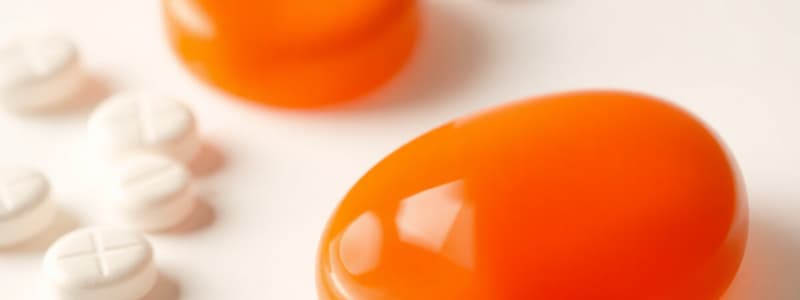Podcast
Questions and Answers
Which of the following factors does NOT directly influence the dissolution rate according to the Noyes-Whitney equation?
Which of the following factors does NOT directly influence the dissolution rate according to the Noyes-Whitney equation?
- Thickness of the diffusion layer
- Diffusion coefficient of the drug
- Surface area of the drug particles
- The drug's brand name (correct)
According to the content, a process is endothermic if -2USL > USS+ULL, where USS represents the energy required to separate solute molecules, ULL is the energy required to separate solvent molecules and USL is the energy released when solute-solvent bonds are formed.
According to the content, a process is endothermic if -2USL > USS+ULL, where USS represents the energy required to separate solute molecules, ULL is the energy required to separate solvent molecules and USL is the energy released when solute-solvent bonds are formed.
False (B)
Explain how increasing the viscosity of a dissolution medium typically impacts the diffusion coefficient and, consequently, the dissolution rate.
Explain how increasing the viscosity of a dissolution medium typically impacts the diffusion coefficient and, consequently, the dissolution rate.
An increase in viscosity typically decreases the diffusion coefficient, hindering the movement of drug molecules and reducing the dissolution rate.
In dissolution testing, maintaining __________ conditions, where the concentration of the drug in the bulk solution is significantly lower than its saturation solubility, is crucial for accurately assessing the intrinsic dissolution properties of a drug.
In dissolution testing, maintaining __________ conditions, where the concentration of the drug in the bulk solution is significantly lower than its saturation solubility, is crucial for accurately assessing the intrinsic dissolution properties of a drug.
Match each dissolution technique with its appropriate description:
Match each dissolution technique with its appropriate description:
For a drug with poor wettability (the ability of a liquid to maintain contact with a solid surface), which strategy is most effective in improving its dissolution rate?
For a drug with poor wettability (the ability of a liquid to maintain contact with a solid surface), which strategy is most effective in improving its dissolution rate?
The melting point of a substance is defined as the temperature at which its solid and liquid phases coexist in equilibrium, and this temperature is always lower than the point at which the substance completely liquefies.
The melting point of a substance is defined as the temperature at which its solid and liquid phases coexist in equilibrium, and this temperature is always lower than the point at which the substance completely liquefies.
Explain the significance of the heat of fusion (ΔH) in the context of drug dissolution and how it relates to the energy requirements for phase transitions.
Explain the significance of the heat of fusion (ΔH) in the context of drug dissolution and how it relates to the energy requirements for phase transitions.
In the context of solid-state chemistry, a __________ polymorph of a drug typically exhibits a higher dissolution rate compared to a more stable polymorph due to its higher energy state.
In the context of solid-state chemistry, a __________ polymorph of a drug typically exhibits a higher dissolution rate compared to a more stable polymorph due to its higher energy state.
Match the following terms with their correct definitions related to drug dissolution:
Match the following terms with their correct definitions related to drug dissolution:
Which of the following is the most accurate description for how the process of dissolution enables drug absorption in the body?
Which of the following is the most accurate description for how the process of dissolution enables drug absorption in the body?
According to the content, increasing the thickness, 'h', of the diffusion layer will increase the overall dissolution rate.
According to the content, increasing the thickness, 'h', of the diffusion layer will increase the overall dissolution rate.
Explain how manipulation of particle properties can influence drug dissolution, and provide specific examples of such properties.
Explain how manipulation of particle properties can influence drug dissolution, and provide specific examples of such properties.
The process where drug molecules relocate from an environment where they are surrounded by identical molecules into a cavity in a liquid, where they are surrounded by nonidentical molecules, is known as _________.
The process where drug molecules relocate from an environment where they are surrounded by identical molecules into a cavity in a liquid, where they are surrounded by nonidentical molecules, is known as _________.
Match the term with the correct description
Match the term with the correct description
Which technique can assess the rate at which a solid drug dissolves but is particularly useful for low-solubility compounds?
Which technique can assess the rate at which a solid drug dissolves but is particularly useful for low-solubility compounds?
In non-sink conditions, the concentration of a drug in the bulk solution (CB) remains significantly lower than its saturation solubility (CS) throughout the dissolution process.
In non-sink conditions, the concentration of a drug in the bulk solution (CB) remains significantly lower than its saturation solubility (CS) throughout the dissolution process.
Describe how different crystalline forms of a drug (polymorphs) can affect its solubility and dissolution rate. Explain why this difference exists at a molecular level.
Describe how different crystalline forms of a drug (polymorphs) can affect its solubility and dissolution rate. Explain why this difference exists at a molecular level.
According to the film theory, the rate of dissolution is directly proportional to the ________ area of the drug particles.
According to the film theory, the rate of dissolution is directly proportional to the ________ area of the drug particles.
Match the following variables from the Noyes-Whitney equation with their description:
Match the following variables from the Noyes-Whitney equation with their description:
Flashcards
Dissolution
Dissolution
The process by which a solid drug substance becomes dissolved in a solvent.
Solubility
Solubility
The mass of solute that dissolves in a specific amount of solvent at a given temperature; a static property.
Melting Point
Melting Point
The temperature at which a substance changes from a solid to a liquid.
Why is drug dissolution important?
Why is drug dissolution important?
Signup and view all the flashcards
Noyes-Whitney Equation
Noyes-Whitney Equation
Signup and view all the flashcards
Sink Conditions
Sink Conditions
Signup and view all the flashcards
Agitation effect on dissolution
Agitation effect on dissolution
Signup and view all the flashcards
Particle size effect on dissolution
Particle size effect on dissolution
Signup and view all the flashcards
Common Dissolution Testing Techniques
Common Dissolution Testing Techniques
Signup and view all the flashcards
Dissolution on a Molecular Level
Dissolution on a Molecular Level
Signup and view all the flashcards
Study Notes
- Dissolution describes the process by which a solid drug substance dissolves into a solvent
- Solubility is the mass of solute dissolving in a specific solvent mass or volume at a temperature
- State of matter includes solid, liquid, or gas
- Melting, requires heat, transforms a solid to a liquid
Melting Point
- The temperature at which a solid changes to a liquid
- Heat of fusion (ΔH) is the heat absorbed or released during thermodynamic state change
Why Drug Dissolution Matters
- Drugs must dissolve in body fluids before absorption, like capsules/tablets dissolving in the gastrointestinal fluid
Dissolution Process
- ΔH accompanies dissolution of a solid in a solvent
- Relocation of solute molecules occurs from an environment of identical molecules into a liquid cavity surrounded by nonidentical molecules
- Moving into liquid involves drug molecules incorporating into the liquid phase from the solid surface
Molecular Level of Dissolution
- ΔHsolution = USS + ULL - 2USL
- Breaking solute-solute interactions requires energy (endothermic)
- Breaking solvent-solvent interactions to fit solute requires energy (endothermic)
- Solute-solvent bonds release energy (exothermic)
Noyes-Whitney Equation
- Describes dissolution rate based on the diffusion model, dC/dt = k·A·(CS-CB)
- dC/dt is the dissolution rate
- k is the dissolution rate constant (D/h)
- D is the diffusion coefficient
- h is the thickness of the diffusion layer ("film thickness")
- A is the surface area
- CS is the saturation solubility of the drug
- CB is the drug concentration in bulk solution
Factors Influencing Drug Dissolution
- Increased agitation of medium increases dissolution
- Viscosity decrease increases dissolution
- Particle properties (size, wetting, porosity) increase dissolution
- Crystalline form increases dissolution
- Volume increase increases dissolution
- Excipients are formulation factors
Techniques to Measure Drug Dissolution
- Techniques such as Beaker Method, Flask Stirrer Method, Rotating Basket Method, Paddle Method, and Flow-Through Cell Method are used
Sink conditions
- CB « CS characterizes as sink conditions
- CB < (0.1 × CS) characterizes dissolution studies
Steps for Dissolution Testing
- Determine CS of the drug in dissolution medium at 37°C
- Measure drug quantity from samples withdrawn at time intervals
- Construct dissolution curve of concentration vs time
Studying That Suits You
Use AI to generate personalized quizzes and flashcards to suit your learning preferences.




